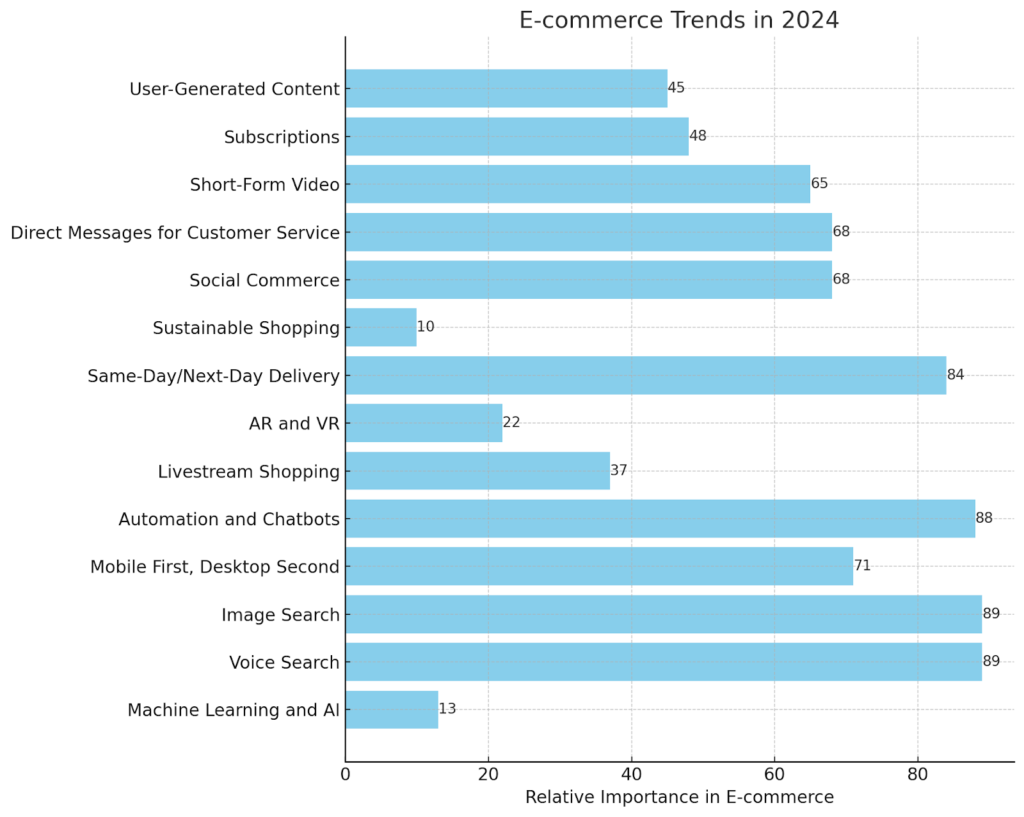The landscape of global commerce has undergone a seismic shift over the past few years, with e-commerce emerging as a dominant force. This digital revolution in shopping and business transactions represents more than a mere trend; it’s a fundamental change in the way consumers interact with brands and make purchases. The rise of e-commerce signifies a new era where convenience, speed, and vast choice are not just valued but expected by customers worldwide.
The COVID-19 pandemic acted as a catalyst in this digital transformation. As physical stores shuttered and social distancing measures took hold, consumers and businesses alike pivoted to online platforms at an unprecedented rate. This shift wasn’t just a temporary response to a global crisis; it marked a permanent change in consumer behavior and business strategies. E-commerce, once a convenience, became a necessity, reshaping the retail landscape in lasting ways.
The Evolution of E-commerce
Tracing the Journey of Online Retail
E-commerce has come a long way from its early days in the late 20th century. Its journey from simple electronic transactions to the sophisticated digital shopping experiences of today is a testament to rapid technological progress and changing consumer needs. Initially, e-commerce was a novel concept, limited by technology and consumer trust. However, as the internet became more accessible and secure, online shopping grew exponentially.
Milestones in the E-commerce Odyssey
Key milestones in the evolution of e-commerce include the development of secure online payment systems, the introduction of mobile commerce, and the advent of personalized shopping experiences powered by artificial intelligence. Each of these advancements played a crucial role in shaping the e-commerce landscape. For instance, the emergence of mobile commerce opened new avenues for shopping convenience, allowing consumers to
purchase from anywhere, at any time, with just a few taps on their smartphones. Similarly, AI and machine learning have revolutionized how businesses understand consumer behavior, enabling personalized marketing and recommendations that have significantly enhanced the online shopping experience.
Launching a Successful E-commerce Business
Establishing Your E-commerce Presence
Launching an e-commerce business requires careful planning and execution. The first step is identifying your niche and conducting thorough market research to understand your target audience’s needs and preferences. This initial phase lays the groundwork for your business strategy and product selection.
Designing an Engaging and User-Friendly Website
The cornerstone of e-commerce is a well-designed website. Your platform should be user-friendly, visually appealing, and optimized for both desktop and mobile users. Key elements include intuitive navigation, fast loading times, high-quality product images, and clear calls to action. Ensuring a seamless and secure checkout process is also crucial for customer retention.
Crafting Effective Digital Marketing Strategies
To drive traffic to your e-commerce site, you’ll need a robust digital marketing strategy. This can include search engine optimization (SEO) to improve your site’s visibility in search engine results, engaging content marketing, and leveraging social media platforms. Additionally, consider using email marketing to nurture leads and retain customers.
Innovative E-commerce Trends
1. AI-Driven Personalization
Artificial Intelligence (AI) is revolutionizing e-commerce by enabling personalized shopping experiences. AI algorithms analyze customer data to provide tailored product recommendations, enhancing customer engagement and boosting sales.
2. Augmented Reality (AR) in Shopping
Augmented Reality (AR) technology is enhancing the online shopping experience by allowing customers to visualize products in real-world settings. This is particularly impactful in industries like furniture and fashion, where AR can significantly reduce uncertainty in the online purchasing process.
3. The Growth of Mobile Commerce
Mobile commerce, or m-commerce, has become an integral part of e-commerce. With the increasing use of smartphones for shopping, businesses are focusing on mobile-responsive designs and dedicated apps to cater to the mobile shopper.
4. The Surge of Social Commerce
Social commerce is the merging of e-commerce with social media. Platforms like Instagram and Facebook now offer direct purchasing options, making it easier for businesses to reach customers where they spend a significant amount of their time online.
5. Embracing Eco-Friendly Packaging
As consumers become more environmentally conscious, e-commerce businesses are adopting eco-friendly packaging solutions. This not only helps in reducing the environmental impact but also resonates with customers who value sustainability.
The Future of E-commerce
Industry Experts Weigh in on E-commerce Evolution
As we look towards the future of e-commerce, industry leaders provide valuable insights into the rapidly evolving landscape of online retail. They emphasize that the future will be shaped by a blend of technological innovation and changing consumer expectations. The acceleration of digital transformation and the growing importance of data analytics are seen as key drivers in reshaping the e-commerce experience.
Anticipating the Impact of Emerging Technologies
Experts predict that emerging technologies like blockchain for secure transactions, the Internet of Things (IoT) for enhanced connectivity, and advanced AI for even more personalized shopping experiences will play pivotal roles. These technologies are expected to make e-commerce more seamless, secure, and tailored to individual consumer preferences. Furthermore, there’s an anticipation of increased integration of virtual and augmented reality into shopping experiences, offering customers a more immersive way to explore products.
2024 E-commerce Trendscape: Diverse Digital Frontiers

The graph offers an insightful overview of the e-commerce landscape for 2024, showcasing a spectrum of trends each with its own degree of influence in the digital marketplace. These trends are visualized as bars of varying lengths, representing their relative importance and impact in the e-commerce industry.
User-Generated Content: This trend emphasizes the increasing reliance on customer-created material for authentic marketing, which is becoming a cornerstone for building brand credibility and trust.
Subscriptions: A model gaining traction across various industries, reflecting a shift in consumer preference for ongoing services over one-time purchases.
Short-Form Video: Highlights the significant role of platforms like TikTok in promoting businesses, illustrating the shift towards engaging, concise video content for marketing.
Direct Messages for Customer Service: Indicates a move towards more personal, immediate customer service interactions via social media platforms, underscoring the need for businesses to adapt to multi-channel communication.
Social Commerce: Showcases the merging of e-commerce with social media, transforming platforms into direct sales channels and tapping into extensive user bases.
Sustainable Shopping: Reflects a growing consumer demand for ethical business practices, including sustainable sourcing and eco-friendly packaging.
Same-Day/Next-Day Delivery: Demonstrates consumer expectations for rapid delivery, pushing businesses to optimize logistics for speed and efficiency.
Augmented Reality (AR) and Virtual Reality (VR): Points to the integration of immersive technologies in online shopping, enhancing the customer experience by allowing virtual product interaction.
Livestream Shopping: A trend indicating the rise of real-time, interactive shopping experiences, blending entertainment with commerce.
Automation and Chatbots: Emphasizes the role of automation in streamlining ordering processes and improving customer service efficiency.
Mobile First, Desktop Second: Captures the shift towards designing e-commerce platforms with a mobile-first approach, in line with the growing preference for mobile shopping.
Image Search: Reflects advancements in visual search technology, enabling customers to search for products using images, thereby enhancing the shopping experience.
Voice Search: The growing prevalence of voice-activated devices and the subsequent rise in voice search for online shopping.
Machine Learning and AI: Underscores the critical role of AI in personalizing the shopping experience, analyzing customer data, and driving e-commerce innovation.
This comprehensive overview encapsulates the multifaceted nature of e-commerce trends in 2024, highlighting the continuous evolution and adaptation required in the digital retail space to meet changing consumer demands and technological advancements.
E-commerce and Customer Experience
The Centrality of Customer Experience in Online Retail
In the realm of e-commerce, customer experience is king. A seamless, engaging, and personalized shopping experience can be the differentiator between a one-time transaction and a loyal customer. As e-commerce becomes more prevalent, businesses are focusing on creating user-centric platforms that are not only easy to navigate but also provide value-added services.
Enhancing Engagement and Satisfaction
To enhance user engagement and satisfaction, e-commerce businesses are implementing various strategies. Personalization, driven by data analytics and AI, allows for tailored recommendations and a more individualized shopping journey. User-friendly website design, with easy navigation and a frictionless checkout process, is crucial. Additionally, efficient customer service, including prompt responses to queries and an easy returns process, significantly improves the overall customer experience. Leveraging customer feedback to continually refine and improve the user experience is also a key practice among successful e-commerce businesses.
FAQs
What are the key steps to starting an e-commerce business?
Starting an e-commerce business involves several key steps: identifying your niche market, conducting market research, setting up your e-commerce platform with a user-friendly design, developing a solid digital marketing strategy, and ensuring efficient logistics and customer service.
How much investment is needed to start an e-commerce business?
The initial investment for an e-commerce business can vary widely depending on the scale and business model. Costs to consider include website development, inventory (if applicable), marketing, and operational expenses. It’s possible to start small and scale up as the business grows.
Is it essential to have a physical store to start an e-commerce business?
No, it’s not essential to have a physical store to start an e-commerce business. Many successful e-commerce businesses operate entirely online, which can significantly reduce the overhead costs associated with physical storefronts.
In conclusion
E-commerce has undeniably transformed the landscape of today’s business world. It has redefined consumer shopping experiences, introduced new operational models, and opened up vast opportunities for innovation and growth. The key to succeeding in this dynamic digital marketplace lies in continual innovation and adaptability. Embracing emerging technologies, understanding evolving consumer behaviors, and maintaining a relentless focus on customer experience are the cornerstones of thriving in the e-commerce era. As the digital world evolves, so too must e-commerce strategies, always looking ahead to the next wave of online retail evolution.

Thomas J. Powell is the Senior Advisor at Brehon Strategies, a seasoned entrepreneur and a private equity expert. With a career in banking and finance that began in 1988 in Silicon Valley, he boasts over three and a half decades of robust experience in the industry. Powell holds dual citizenship in the European Union and the United States, allowing him to navigate international business environments with ease. A Doctor of Law and Policy student at Northeastern University, he focuses on middle-income workforce housing shortages in rural resort communities. He blends his professional acumen with a strong commitment to community service, having been associated with the Boys and Girls Clubs of America for over 45 years. Follow Thomas J Powell on LinkedIn, Twitter,Crunchbase.

